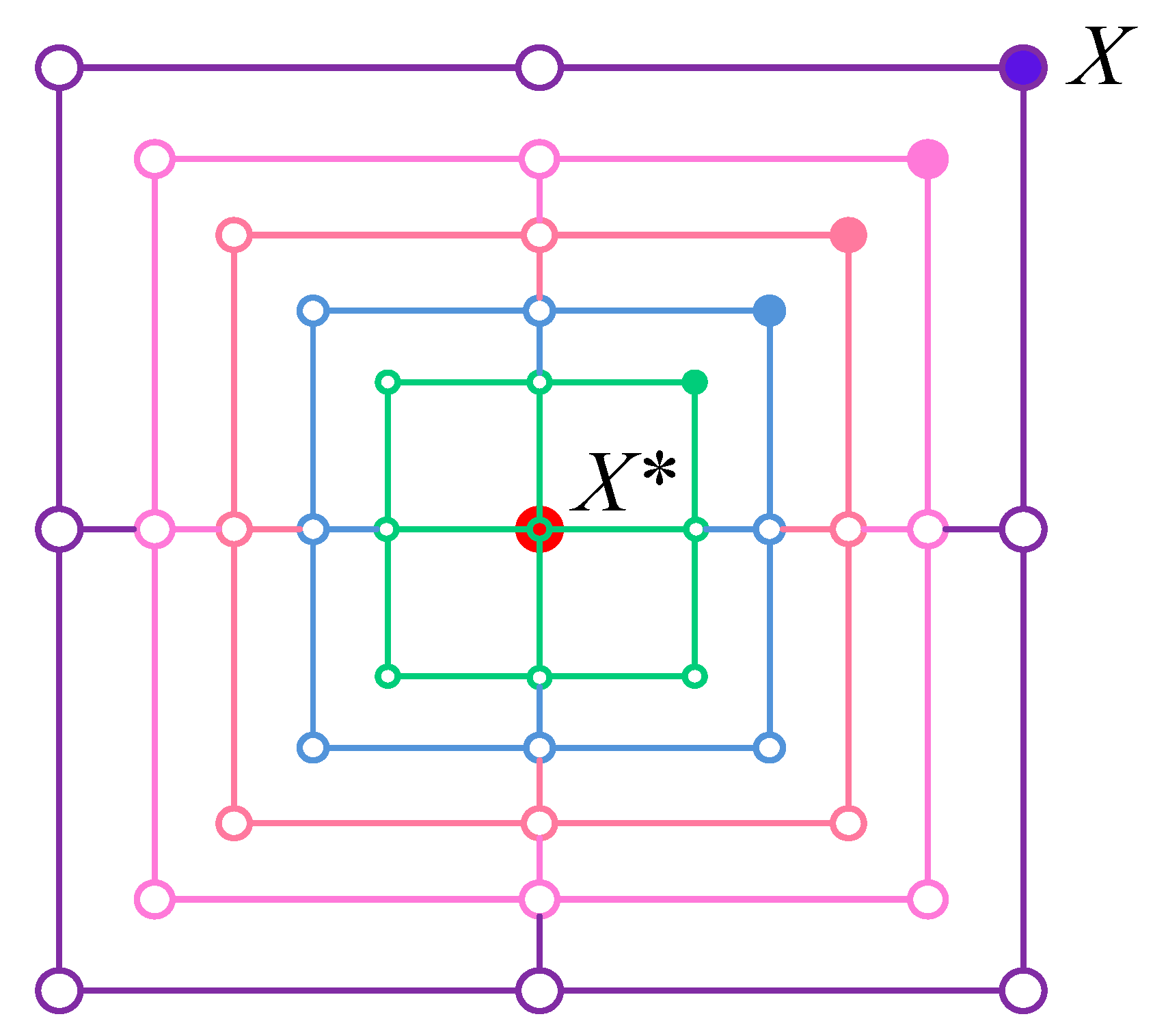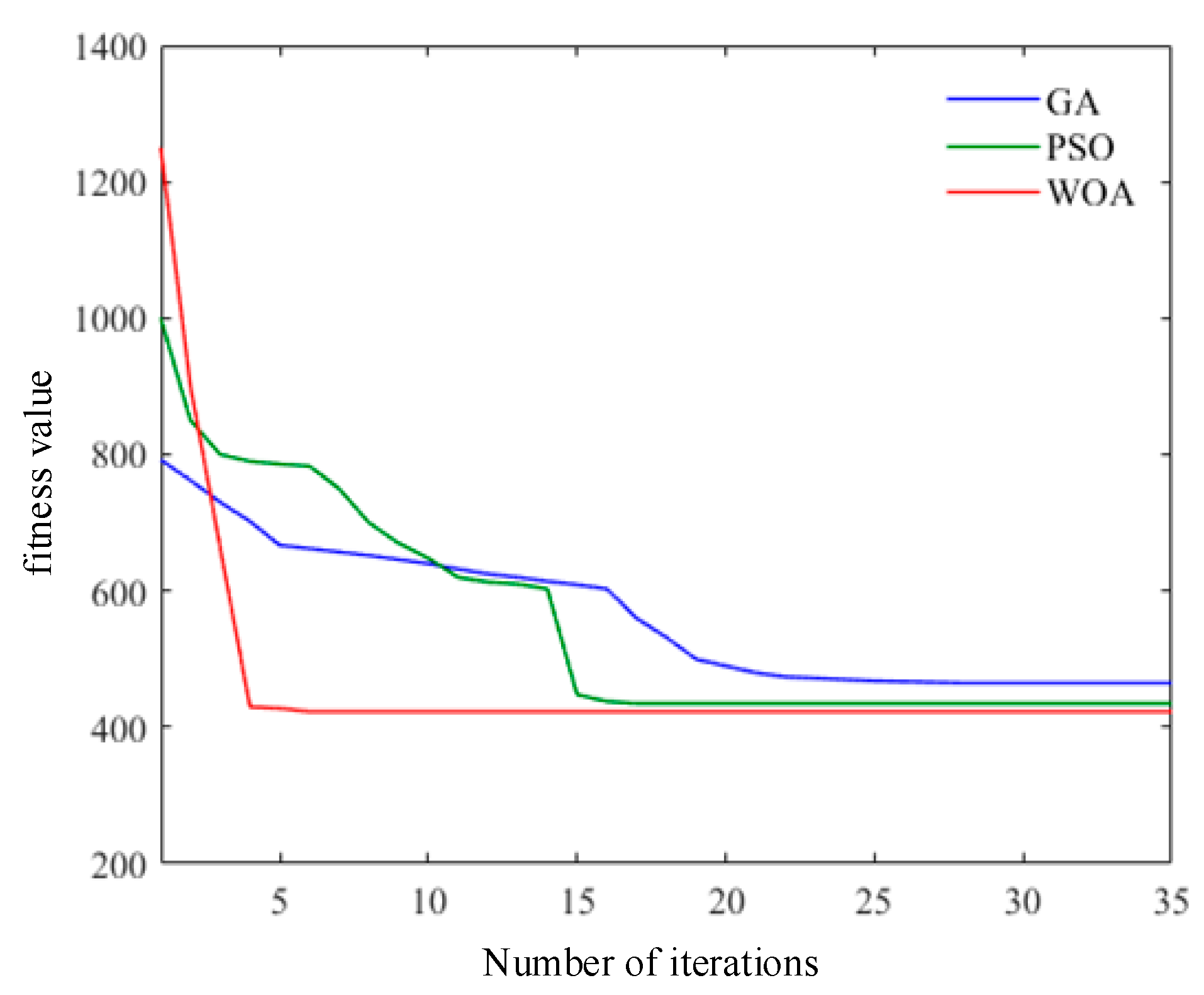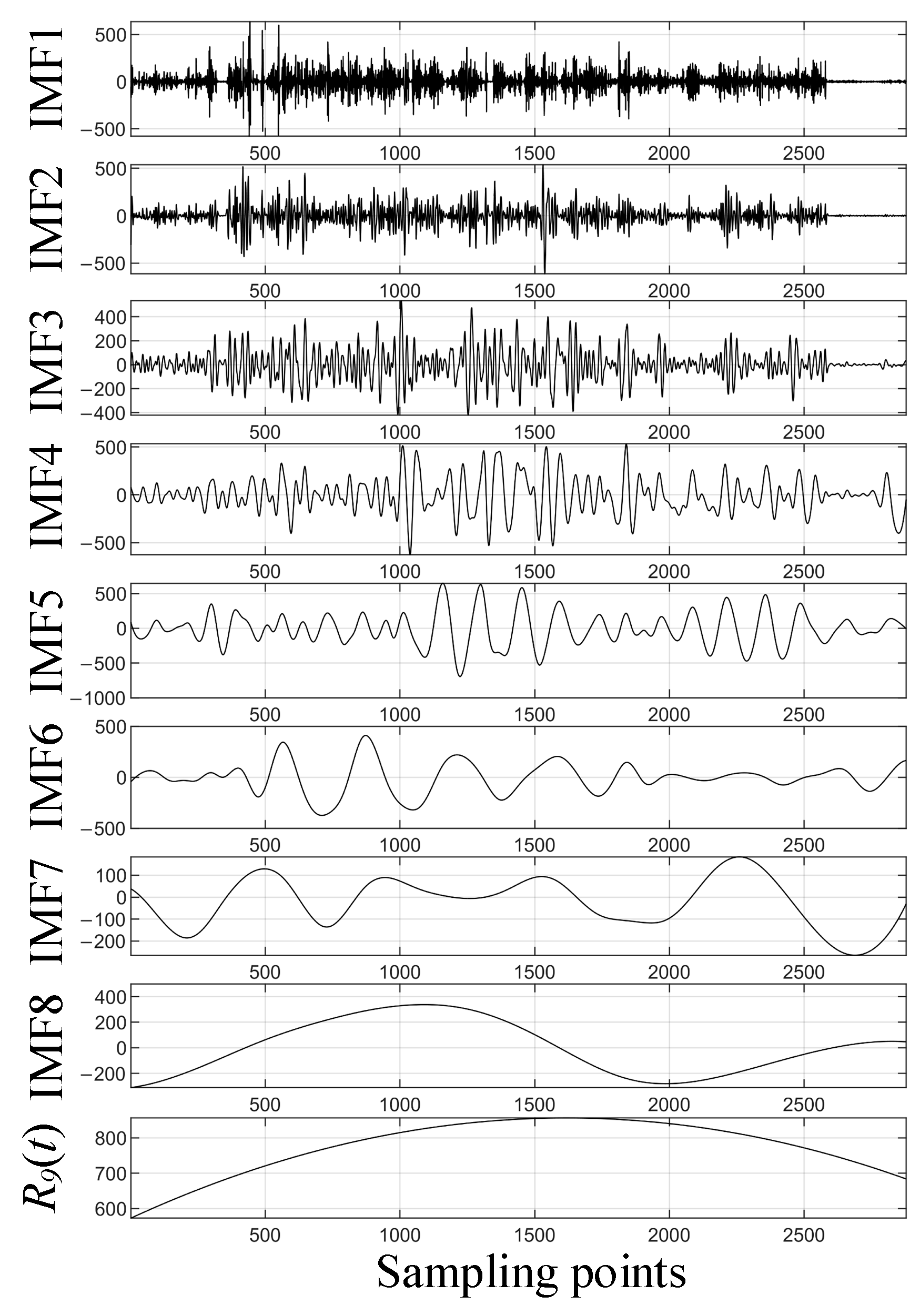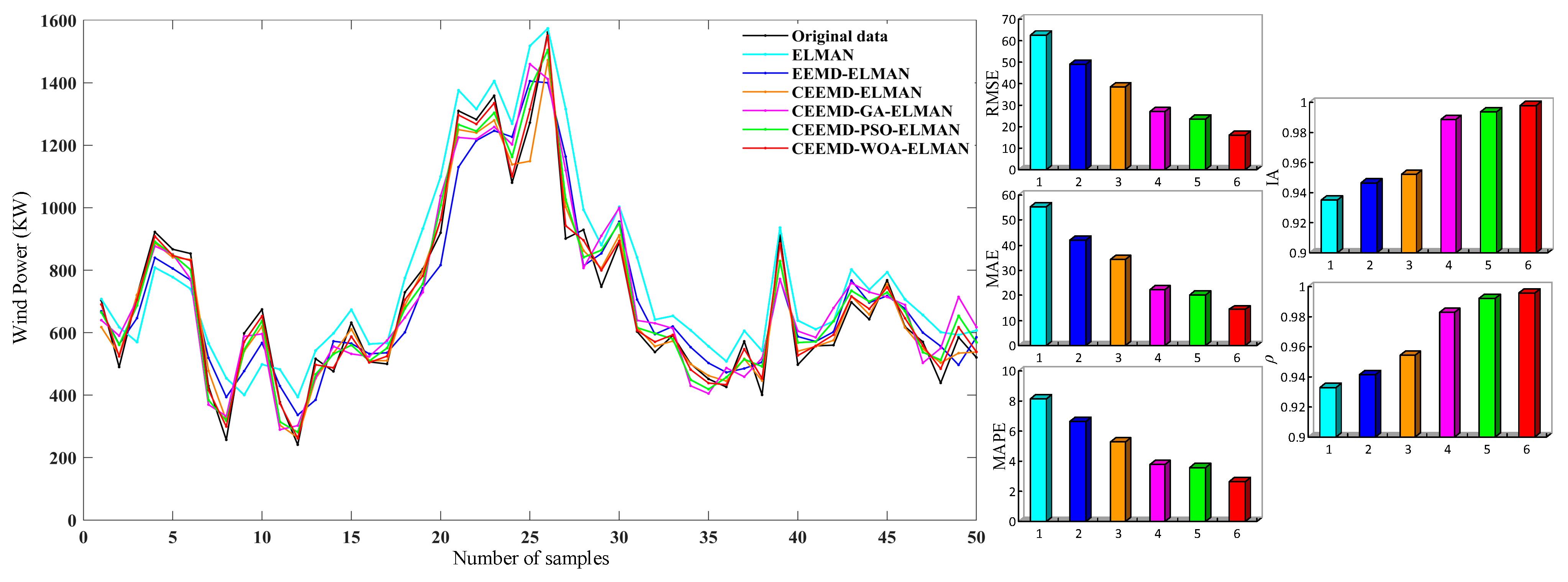Ultra-Short-Term Wind Power Combined Prediction Based on Complementary Ensemble Empirical Mode Decomposition, Whale Optimisation Algorithm, and Elman Network
Abstract
:1. Introduction
2. CEEMD Method
2.1. Empirical Mode Decomposition
2.2. EEMD
- (1)
- Determination of the decomposition times and the amplitude standard deviation of Gaussian white noise.
- (2)
- Gaussian white noise with a mean value of 0 and standard deviation of constant is added to the original sequence many times as follows:where is the signal in which Gaussian white noise is added for the i-th time.
- (3)
- The IMF component and the residual component are obtained by EEMD decomposition of . The result of decomposition is expressed as follows:
2.3. Complementary EEMD
- (1)
- Positive and negative white noise is added to the original signal to obtain the synthetic signal .
- (2)
- The paired synthetic signals obtained by Equation (5) are decomposed by EMD, as follows:where is the j-th intrinsic mode function IMF or residual component of the synthetic signal after addition of the positive white noise signal in the i-th trial; is the j-th intrinsic mode function IMF or residual component of the synthetic signal after adding negative white noise signal in the i-th trial; m is the total number of IMF and the residual components.
- (3)
- Equations (5) and (6) are repeated M times to obtain a set of M of IMF and residual components as follows:
- (4)
- The pooled average of all IMFs and residual components is calculated, which is the IMF and residual components obtained from CEEMD as follows:
- (5)
- The original sequence can be decomposed as follows:
3. Introduction to the WOA
- (1)
- Searching for prey. Whales achieve food hunting by constantly updating their position when searching for prey, as expressed in the following equations:where D is the distance between the whale and the prey; t is the number of current iterations; Xrand is the random position vector of the whale; X is the position vector; and A and C are the coefficients.
- (2)
- Surrounding the prey. The whale can identify and cover the location of the prey. Determining the location of the optimal solution in the search space in advance is difficult; therefore, in WOA, the target prey location is assumed to be the initial optimal solution or the closest optimal solution location. When the optimal individual position is determined, other whales try to approach the optimal position and update their positions. The whale encirclement hunting is expressed as follows:where X*(t) is the position of the current optimal solution and is updated in each iteration, and X(t) is the current position vector.
- (3)
- Spiral bubble netting for hunting. The whale spiral bubble-net hunting is expressed as follows:where is the distance between the best whale in position and the prey (the current best solution); b is a constant that defines the shape of the spiral; and l is a random value between −1 and 1.
4. Introduction to the Elman Neural Network
4.1. Elman Neural Network Model
4.2. Introduction to the Elman Network Algorithm
5. Establishment of the CEEMD–WOA–ELMAN Prediction Model
- (1)
- The original wind power signal is decomposed using CEEMD to obtain n IMF components and one residual component rn(t), and a suitable IMF is selected.
- (2)
- The decomposed IMF components and residual components of the training set are used as the inputs of each component of the Elman wind power model, and the WOA is used to optimise the weights and thresholds of each component of the model to obtain the optimised prediction model of each component.
- (3)
- In prediction, each IMF component and residual component after decomposition of the test set are inputted into the trained Elman model of each component for prediction, and the predicted values of each component are obtained.
- (4)
- The predicted values of each component are superimposed to obtain the final wind power prediction at a certain moment.
- (5)
- Error analysis of the obtained predicted wind power and the actual wind power data is performed.
6. Example and Analysis of Results
6.1. Optimised Performance Analysis of WOA
6.2. CEEMD Decomposition of Wind Power Series
6.3. Ultra-Short-Term Wind Power Prediction Based on CEEMD–WOA–ELMAN
7. Conclusions
- (1)
- The CEEMD technique can effectively avoid the defect of EEMD with large residual auxiliary noise. In this study, for the CEEMD decomposition of ultra-short-term wind power, a suitable number of IMF components were selected to reduce the complexity of the prediction process.
- (2)
- In this study, we introduce the WOA with a strong optimising ability to optimise the weights and thresholds of the Elman model, which improves the accuracy of wind power prediction considerably.
- (3)
- By comparing the WOA with the GA and PSO, we find that the WOA exhibits a fast convergence speed and can effectively avoid falling into local extremes to achieve the optimal effect.
- (4)
- The actual operating data of two wind turbines in a wind farm are analysed for model performance verification, which indicates that the CEEMD method can obtain smoother IMF components, and the CEEMD–WOA–ELMAN model can achieve superior wind power prediction, further verifying the superiority of the proposed model for achieving excellent wind power prediction.
- (5)
- The proposed method in this study is better in predicting trend following and prediction accuracy and is suitable for predicting wind power time series with high volatility and strong nonlinearity. Although the proposed method performs well, 15 min is selected as the prediction interval in this study, and different time scales may have different impact results. In the future, the effects of various time scales on ultra-short-term wind power prediction should be analysed, and the model should be optimised to reduce the running time and improve model accuracy.
Author Contributions
Funding
Institutional Review Board Statement
Informed Consent Statement
Data Availability Statement
Conflicts of Interest
References
- Lujano-Rojas, J.; Osório, G.; Matias, J.; Catalão, J. A heuristic methodology to economic dispatch problem incorporating renewable power forecasting error and system reliability. Renew. Energy 2016, 87, 731–743. [Google Scholar] [CrossRef]
- Carta, J.A.; Velázquez, S.; Cabrera, P. A review of measure-correlate-predict (MCP) methods used to estimate long-term wind characteristics at a target site. Renew. Sust. Energy. Rev. 2013, 27, 362–400. [Google Scholar] [CrossRef]
- Tascikaraoglu, A.; Uzunoglu, M. A review of combined approaches for prediction of short-term wind speed and power. Renew. Sust. Energy Rev. 2014, 34, 243–254. [Google Scholar] [CrossRef]
- Sarwat, A.I.; Amini, M.; Domijan, A.; Damnjanovic, A.; Kaleem, F. Weather-based interruption prediction in the smart grid utilizing chronological data. J. Mod. Power Syst. Clean Energy 2016, 4, 1–8. [Google Scholar] [CrossRef] [Green Version]
- Liu, H.; Mi, X.; Li, Y. Wind speed forecasting method based on deep learning strategy using empirical wavelet transform, long short term memory neural network and Elman neural network. Energy Convers. Manag. 2018, 156, 498–514. [Google Scholar] [CrossRef]
- Khosravi, A.; Machado, L.; Nunes, R. Time-series prediction of wind speed using machine learning algorithms: A case study Osorio wind farm, Brazil. Appl. Energy 2018, 224, 550–566. [Google Scholar] [CrossRef]
- Liu, Y.; Guan, L.; Hou, C.; Han, H.; Liu, Z.; Sun, Y.; Zheng, M. Wind power short-term prediction based on LSTM and discrete wavelet transform. Appl. Sci. 2019, 9, 1108. [Google Scholar] [CrossRef] [Green Version]
- Li, L.; Liu, Y.; Yang, Y.; Han, S.; Wang, Y. A physical approach of the short-term wind power prediction based on CFD pre-calculated flow fields. J. Hydrodyn. Ser. B 2013, 25, 56–61. [Google Scholar] [CrossRef]
- Okumus, I.; Dinler, A. Current status of wind energy forecasting and a hybrid method for hourly predictions. Energy Convers. Manag. 2016, 123, 362–371. [Google Scholar] [CrossRef]
- Papaefthymiou, G.; Klockl, B. MCMC for wind power simulation. IEEE Trans. Energy Convers. 2008, 23, 234–240. [Google Scholar] [CrossRef] [Green Version]
- Taylor, J.W.; McSharry, P.E.; Buizza, R. Wind power density forecasting using ensemble predictions and time series models. IEEE Trans. Energy Convers. 2009, 24, 775–782. [Google Scholar] [CrossRef]
- Heinermann, J.; Kramer, O. Machine learning ensembles for wind power prediction. Renew. Energy 2016, 89, 671–679. [Google Scholar] [CrossRef]
- Arshad, J.; Zameer, A.; Khan, A. Wind power prediction using genetic programming based ensemble of artificial neural networks (GPeANN). In Proceedings of the 2014 12th International Conference on Frontiers of Information Technology, Islamabad, Pakistan, 17–19 December 2014. [Google Scholar]
- Wang, C.; Zhang, H.; Fan, W.; Ma, P. A new chaotic time series hybrid prediction method of wind power based on EEMD-SE and full-parameters continued fraction. Energy 2017, 138, 977–990. [Google Scholar] [CrossRef]
- Huang, C.Y. Analysis on Application of Wavelet Neural Network in Wind Electricity Power Prediction. Appl. Mech. Mater. 2014, 686, 627–633. [Google Scholar] [CrossRef]
- De Aquino, R.R.; Neto, O.N.; Souza, R.B.; Lira, M.M.; Carvalho, M.A.; Ludermir, T.B.; Ferreira, A.A. Investigating the use of echo state networks for prediction of wind power generation. In Proceedings of the 2014 IEEE Symposium on Computational Intelligence for Engineering Solutions (CIES), Orlando, FL, USA, 9–12 December 2014. [Google Scholar]
- Fang, B.; Liu, D.; Wang, B.; Yan, B.; Wang, X. Forecast of Short-term Wind Speed Based on Wavelet Transform and Improved Firefly LSSVM Algorithm. Prot. Control Power Syst. 2016, 44, 37–43. [Google Scholar]
- Kurbatskii, V.G.; Sidorov, D.N.; Spiryaev, V.A.; Tomin, N.V. On the neural network approach for forecasting of nonstationary time series on the basis of the Hilbert-Huang transform. Autom. Remote Control 2011, 72, 1405–1414. [Google Scholar] [CrossRef]
- Lv, S.X.; Wang, L. Deep learning combined wind speed forecasting with hybrid time series decomposition and multi-objective parameter optimization. Appl. Energy 2022, 311, 118674. [Google Scholar] [CrossRef]
- Wang, J.; Wang, S.; Zeng, B.; Lu, H. A novel ensemble probabilistic forecasting system for uncertainty in wind speed. Appl. Energy 2022, 313, 118796. [Google Scholar] [CrossRef]
- Zhang, G.; Wu, Y.; Wong, K.P.; Xu, Z.; Dong, Z.Y.; Iu, H.-C. An advanced approach for construction of optimal wind power pre-diction intervals. IEEE Trans. Power Syst. 2015, 30, 2706–2715. [Google Scholar] [CrossRef]
- Yu, C.; Li, Y.; Zhang, M. Comparative study on three new hybrid models using Elman Neural Network and Empirical Mode Decomposition based technologies improved by Singular Spectrum Analysis for hour-ahead wind speed forecasting. Energy Convers. Manag. 2017, 147, 75–85. [Google Scholar] [CrossRef]
- Su, Y.; Wang, S.; Xiao, Z.; Tan, M.; Wang, M. An ultra-short-term wind power forecasting approach based on wind speed decomposition, wind direction and elman neural networks. In Proceedings of the 2018 2nd IEEE Conference on Energy Internet and Energy System Integration (EI2), Beijing, China, 20–22 October 2018. [Google Scholar]
- Wang, K.; Niu, D.; Sun, L.; Zhen, H.; Liu, J.; De, G.; Xu, X. Wind power short-term forecasting hybrid model based on CEEMD-SE method. Processes 2019, 7, 843. [Google Scholar] [CrossRef] [Green Version]
- Sun, Z.; Liu, Y.; Xu, M.; Guan, W. Wind power prediction based on Elman neural network model optimized by improved genetic algorithm. In Proceedings of the 2021 IEEE 2nd International Conference on Big Data, Artificial Intelligence and Internet of Things Engineering (ICBAIE), Nanchang, China, 26–28 March 2021. [Google Scholar]
- Xie, K.; Yi, H.; Hu, G.; Li, L.; Fan, Z. Short-term power load forecasting based on Elman neural network with particle swarm optimization. Neurocomputing 2020, 416, 136–142. [Google Scholar] [CrossRef]
- Osama, S.; Houssein, E.H.; Hassanien, A.E.; Fahmy, A.A. Forecast of wind speed based on whale optimization algorithm. In Proceedings of the Proceedings of the 1st International Conference on Internet of Things and Machine Learning, Liverpool, UK, 17–18 October 2017. [Google Scholar]
- Wang, H.; Lv, X.; Luo, X. Short-term Load Forecasting of Power grid Based on Improved WOA Optimized LSTM. In Proceedings of the 2020 5th International Conference on Power and Renewable Energy (ICPRE), Shanghai, China, 12–14 September 2020. [Google Scholar]
- Huang, N.E.; Shen, Z.; Long, S.R.; Wu, M.C.; Shih, H.H.; Zheng, Q.; Yen, N.-C.; Tung, C.C.; Liu, H.H. The empirical mode decomposition and the Hilbert spectrum for nonlinear and non-stationary time series analysis. Proc. R. Soc. Lond. Ser. A 1998, 454, 903–995. [Google Scholar] [CrossRef]
- Wu, Z.; Huang, N.E. Ensemble empirical mode decomposition: A noise-assisted data analysis method. Adv. Adapt. Data Anal. 2009, 1, 1–41. [Google Scholar] [CrossRef]
- Wang, J.; Zhang, W.; Li, Y.; Wang, J.; Dang, Z. Forecasting wind speed using empirical mode decomposition and Elman neural network. Appl. Soft Comput. 2014, 23, 452–459. [Google Scholar] [CrossRef]
- Yeh, J.R.; Shieh, J.S.; Huang, N.E. Complementary ensemble empirical mode decomposition: A novel noise enhanced data analysis method. Adv. Adapt. Data Anal. 2010, 2, 135–156. [Google Scholar] [CrossRef]
- Mirjalili, S.; Lewis, A. The whale optimization algorithm. Adv. Eng. Softw. 2016, 95, 51–67. [Google Scholar] [CrossRef]
- Elman, J.L. Finding structure in time. Cogn Sci. 1990, 14, 179–211. [Google Scholar] [CrossRef]
- Zhang, X.; Wang, R.; Liao, T.; Zhang, T.; Zha, Y. Short-term forecasting of wind power generation based on the similar day and Elman neural network. In Proceedings of the 2015 IEEE Symposium Series on Computational Intelligence, Cape Town, South Africa, 7–10 December 2015. [Google Scholar]
- Osório, G.J.; Matias, J.C.O.; Catalão, J.P.S. Short-term wind power forecasting using adaptive neuro-fuzzy inference system combined with evolutionary particle swarm optimization, wavelet transform and mutual information. Renew. Energy 2015, 75, 301–307. [Google Scholar] [CrossRef]
- Jiang, Z.; Che, J.; Wang, L. Ultra-short-term wind speed forecasting based on EMD-VAR model and spatial correlation. Energy Convers. Manag. 2021, 250, 114919. [Google Scholar] [CrossRef]












| Prediction Method | RMSE | MAE | MAPE | IA | |
|---|---|---|---|---|---|
| GA–ELMAN | 35.5133 | 30.6847 | 4.8578 | 0.9646 | 0.9604 |
| PSO–ELMAN | 30.3242 | 27.4234 | 4.5706 | 0.9762 | 0.9653 |
| WOA–ELMAN | 28.4552 | 25.1618 | 4.1173 | 0.9819 | 0.9726 |
| Predictive Models | RMSE | MAE | MAPE | IA | |
|---|---|---|---|---|---|
| ELMAN | 62.6313 | 55.4153 | 8.1275 | 0.9352 | 0.9328 |
| EEMD–ELMAN | 48.9622 | 42.1292 | 6.6749 | 0.9464 | 0.9414 |
| CEEMD–ELMAN | 38.3632 | 34.2585 | 5.2809 | 0.9519 | 0.9542 |
| CEEMD–GA–ELMAN | 26.9245 | 22.2847 | 3.8168 | 0.9885 | 0.9829 |
| CEEMD–PSO–ELMAN | 23.6354 | 20.0438 | 3.5672 | 0.9934 | 0.9921 |
| CEEMD–WOA–ELMAN | 16.1332 | 14.3704 | 2.6381 | 0.9978 | 0.9959 |
| Predictive Models | RMSE | MAE | MAPE | IA | |
|---|---|---|---|---|---|
| ELMAN | 56.1573 | 49.1307 | 7.5285 | 0.9467 | 0.9485 |
| EEMD–ELMAN | 43.5248 | 40.2365 | 6.3507 | 0.9531 | 0.9523 |
| CEEMD–ELMAN | 37.7319 | 35.5331 | 5.1657 | 0.9605 | 0.9587 |
| CEEMD–GA–ELMAN | 24.6524 | 21.5278 | 3.6285 | 0.9892 | 0.9856 |
| CEEMD–PSO–ELMAN | 21.8258 | 19.3365 | 3.4536 | 0.9964 | 0.9934 |
| CEEMD–WOA–ELMAN | 13.2642 | 11.6409 | 2.4158 | 0.9986 | 0.9967 |
Publisher’s Note: MDPI stays neutral with regard to jurisdictional claims in published maps and institutional affiliations. |
© 2022 by the authors. Licensee MDPI, Basel, Switzerland. This article is an open access article distributed under the terms and conditions of the Creative Commons Attribution (CC BY) license (https://creativecommons.org/licenses/by/4.0/).
Share and Cite
Zhu, A.; Zhao, Q.; Wang, X.; Zhou, L. Ultra-Short-Term Wind Power Combined Prediction Based on Complementary Ensemble Empirical Mode Decomposition, Whale Optimisation Algorithm, and Elman Network. Energies 2022, 15, 3055. https://doi.org/10.3390/en15093055
Zhu A, Zhao Q, Wang X, Zhou L. Ultra-Short-Term Wind Power Combined Prediction Based on Complementary Ensemble Empirical Mode Decomposition, Whale Optimisation Algorithm, and Elman Network. Energies. 2022; 15(9):3055. https://doi.org/10.3390/en15093055
Chicago/Turabian StyleZhu, Anfeng, Qiancheng Zhao, Xian Wang, and Ling Zhou. 2022. "Ultra-Short-Term Wind Power Combined Prediction Based on Complementary Ensemble Empirical Mode Decomposition, Whale Optimisation Algorithm, and Elman Network" Energies 15, no. 9: 3055. https://doi.org/10.3390/en15093055
APA StyleZhu, A., Zhao, Q., Wang, X., & Zhou, L. (2022). Ultra-Short-Term Wind Power Combined Prediction Based on Complementary Ensemble Empirical Mode Decomposition, Whale Optimisation Algorithm, and Elman Network. Energies, 15(9), 3055. https://doi.org/10.3390/en15093055






